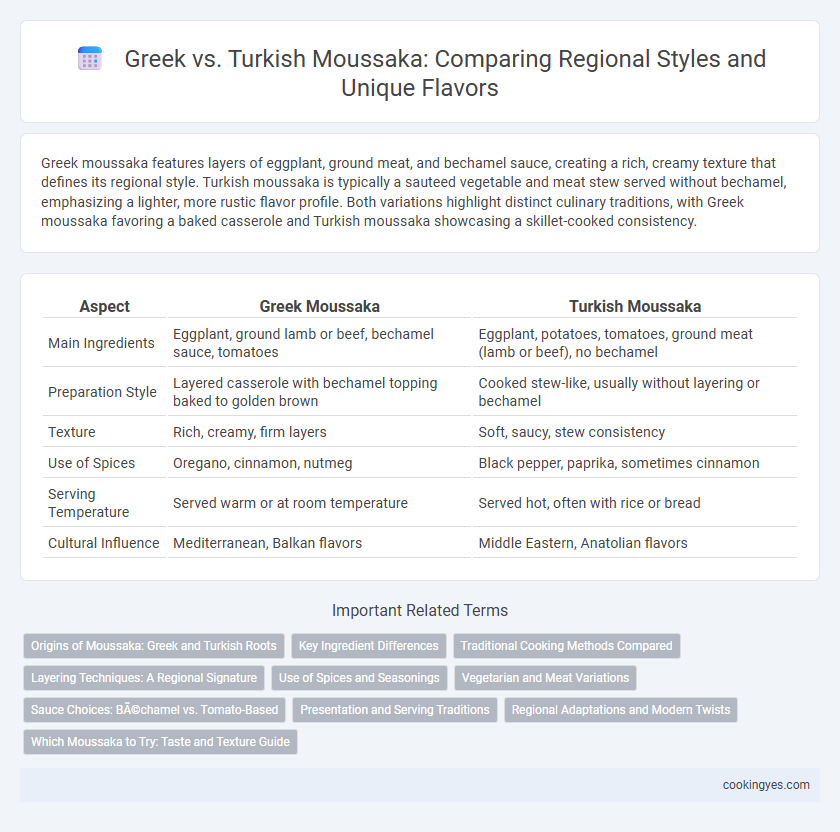Greek moussaka features layers of eggplant, ground meat, and bechamel sauce, creating a rich, creamy texture that defines its regional style. Turkish moussaka is typically a sauteed vegetable and meat stew served without bechamel, emphasizing a lighter, more rustic flavor profile. Both variations highlight distinct culinary traditions, with Greek moussaka favoring a baked casserole and Turkish moussaka showcasing a skillet-cooked consistency.
Table of Comparison
| Aspect | Greek Moussaka | Turkish Moussaka |
|---|---|---|
| Main Ingredients | Eggplant, ground lamb or beef, bechamel sauce, tomatoes | Eggplant, potatoes, tomatoes, ground meat (lamb or beef), no bechamel |
| Preparation Style | Layered casserole with bechamel topping baked to golden brown | Cooked stew-like, usually without layering or bechamel |
| Texture | Rich, creamy, firm layers | Soft, saucy, stew consistency |
| Use of Spices | Oregano, cinnamon, nutmeg | Black pepper, paprika, sometimes cinnamon |
| Serving Temperature | Served warm or at room temperature | Served hot, often with rice or bread |
| Cultural Influence | Mediterranean, Balkan flavors | Middle Eastern, Anatolian flavors |
Origins of Moussaka: Greek and Turkish Roots
Moussaka originates from the Eastern Mediterranean, with Greek and Turkish culinary traditions each offering distinct regional styles. Greek Moussaka is characterized by layered eggplant, ground lamb, and bechamel sauce, reflecting Ottoman influences adapted to local ingredients. Turkish Moussaka typically features diced vegetables and meat cooked together without layering, highlighting a stew-like consistency rooted in Anatolian cooking practices.
Key Ingredient Differences
Greek moussaka features layers of eggplant, ground lamb, and a rich bechamel sauce, emphasizing creamy texture and a baked finish. Turkish moussaka often consists of sauteed vegetables such as eggplants, tomatoes, and peppers, cooked in olive oil without a bechamel topping, highlighting a stew-like consistency. The key ingredient difference lies in Greek moussaka's use of bechamel and lamb versus Turkish moussaka's vegetable-heavy, olive oil-based preparation.
Traditional Cooking Methods Compared
Greek moussaka features layers of eggplant, ground lamb, and bechamel sauce baked to a golden crust, showcasing traditional oven baking techniques that emphasize creamy textures and balanced spices. Turkish moussaka is typically sauteed rather than baked, with diced vegetables and meat cooked together to create a stew-like dish that highlights sauteing and slow simmering methods. The regional styles reflect distinct culinary traditions: Greek moussaka's layered assembly contrasts with the Turkish approach of integrating ingredients during cooking, resulting in unique flavor profiles and textures.
Layering Techniques: A Regional Signature
Greek moussaka typically features distinct, separate layers of eggplant, ground meat, and bechamel sauce, creating a structured presentation emblematic of its regional style. In contrast, Turkish moussaka often employs a more blended layering technique where ingredients are cooked together and served as a stew or casserole, highlighting a softer, integrated texture. These layering differences underline the unique culinary signatures and cultural preferences of each region.
Use of Spices and Seasonings
Greek moussaka is characterized by its rich use of cinnamon, nutmeg, and allspice, which impart a warm and aromatic flavor to the eggplant and ground meat layers. In contrast, Turkish moussaka emphasizes simpler seasoning with tomato, garlic, and olive oil, allowing the freshness of the vegetables to stand out more prominently. The regional spice variations reflect broader culinary traditions, with Greek versions leaning towards Mediterranean warmth and Turkish styles prioritizing a lighter, vegetable-forward profile.
Vegetarian and Meat Variations
Greek moussaka traditionally features layers of eggplant, ground lamb or beef, and bechamel sauce, emphasizing a rich, creamy texture, while Turkish moussaka tends to be more stew-like with diced vegetables and meat cooked together without bechamel. Vegetarian variations in Greek cuisine often replace meat with mushrooms or lentils, maintaining the layered structure and creamy top, whereas Turkish vegetarian moussaka uses zucchini, eggplant, and tomato base without layering. Both regional styles highlight local spices and seasonal vegetables, reflecting distinct culinary traditions within the shared moussaka heritage.
Sauce Choices: Béchamel vs. Tomato-Based
Greek moussaka features a rich bechamel sauce made from butter, flour, and milk, offering a creamy and silky texture that balances the layers of eggplant, minced meat, and spices. In contrast, Turkish moussaka relies on a tomato-based sauce infused with garlic, onions, and olive oil, providing a lighter, tangier profile that emphasizes Mediterranean freshness. These distinct sauce choices highlight the regional variations in flavor and texture, reflecting cultural preferences in Greek and Turkish culinary traditions.
Presentation and Serving Traditions
Greek moussaka features distinct layers of eggplant, minced meat, and bechamel sauce baked to a golden crust, typically served as a main dish in square portions. In contrast, Turkish moussaka is usually a stewed mixture of eggplants, tomatoes, and ground meat, presented as a warm, saucy side dish or meze in a shallow bowl. Serving traditions emphasize Greece's formal, plated presentation versus Turkey's communal, shared dining style.
Regional Adaptations and Modern Twists
Greek Moussaka traditionally layers sauteed eggplant, minced lamb, and bechamel sauce, emphasizing creamy textures and aromatic spices like cinnamon and nutmeg, while Turkish Moussaka typically serves as a sauteed vegetable stew with eggplant, tomatoes, and green peppers, often without a bechamel topping. Regional adaptations in Greece include adding potatoes or zucchini, while modern twists incorporate vegan versions using lentils or plant-based bechamel alternatives to cater to dietary preferences. The evolution of Moussaka reflects diverse culinary influences, balancing tradition with innovation across Eastern Mediterranean cuisines.
Which Moussaka to Try: Taste and Texture Guide
Greek moussaka features layered eggplant, ground lamb, and a creamy bechamel sauce, offering a rich, creamy texture with a balance of savory and mildly spiced flavors. Turkish moussaka often serves as a sauteed vegetable stew with eggplant, tomatoes, and green peppers, providing a lighter, tangy, and more vegetable-forward taste. For a hearty, indulgent experience, Greek moussaka is ideal, while Turkish moussaka suits those seeking a fresher, more vibrant dish with pronounced Mediterranean vegetable notes.
Greek vs Turkish Moussaka for Regional Style Infographic

 cookingyes.com
cookingyes.com